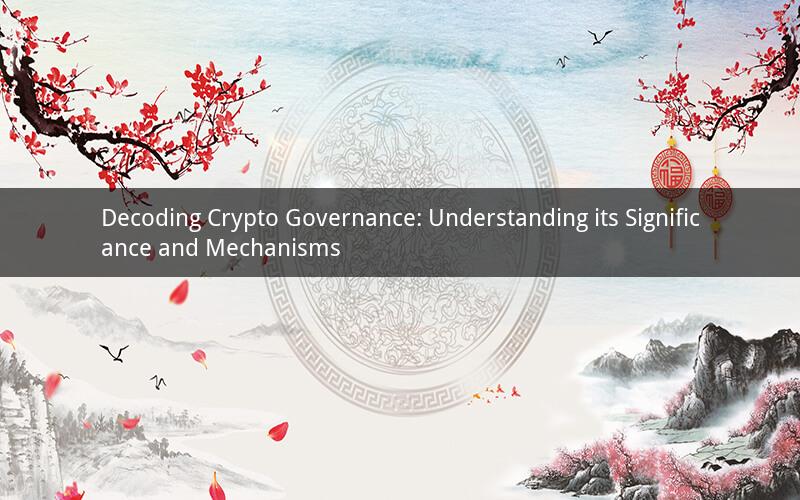
In the rapidly evolving landscape of cryptocurrencies, governance stands as a cornerstone of the ecosystem. As the term "crypto governance" implies, it refers to the process by which participants in the cryptocurrency space make decisions, regulate their communities, and maintain the integrity of the blockchain network. This article aims to explore the essence of crypto governance, its significance, and the various mechanisms through which it operates.
Significance of Crypto Governance
1. Ensuring Security and Stability: One of the primary goals of crypto governance is to safeguard the security and stability of the blockchain network. By implementing robust governance mechanisms, the community can mitigate risks associated with hacking, fraud, and other malicious activities.
2. Enhancing Trust: In a decentralized world, trust plays a vital role. Effective governance fosters trust among participants by establishing transparent and fair processes. This trust is essential for the long-term success and adoption of cryptocurrencies.
3. Encouraging Innovation: A well-governed crypto ecosystem fosters innovation by allowing participants to propose and implement new features, improvements, and solutions. This, in turn, contributes to the continuous evolution and growth of the blockchain technology.
4. Mitigating Centralization: Crypto governance helps prevent centralization by distributing decision-making power across the community. This decentralized approach ensures that no single entity has disproportionate control over the network.
5. Adapting to Changes: The crypto industry is highly dynamic. Effective governance enables the community to adapt to regulatory changes, market trends, and technological advancements, ensuring the relevance and sustainability of cryptocurrencies.
Mechanisms of Crypto Governance
1. Voting Systems: One of the most common mechanisms for crypto governance is the use of voting systems. These systems allow token holders to participate in decision-making processes by casting their votes on various proposals. The outcome of these votes can determine the direction of the project or the implementation of specific features.
2. Councils and Boards: Some crypto projects establish councils or boards to oversee the governance process. These councils consist of members who are responsible for making decisions on behalf of the community. Members of these councils are often chosen through a combination of election and appointment processes.
3. Forking: Forking is a mechanism used to resolve disputes or implement significant changes in a blockchain network. When a fork occurs, the community is divided into two separate chains, with each chain following its own set of rules and governance structures.
4. DAOs (Decentralized Autonomous Organizations): DAOs are blockchain-based organizations that operate without a central authority. They use smart contracts to govern their operations, making decisions through collective voting of their members.
5. Proposals and Discussions: Many crypto projects rely on a proposal system, where community members can submit suggestions for improvements or changes. These proposals are then discussed and voted upon by the community, ensuring that the governance process remains open and inclusive.
Challenges and Considerations in Crypto Governance
1. Centralization Risks: Despite the decentralized nature of crypto governance, there are still risks of centralization. Large token holders can exert disproportionate influence on decision-making processes, leading to potential conflicts of interest.
2. Regulatory Compliance: Cryptocurrency projects must navigate a complex regulatory landscape, which can be challenging under a decentralized governance model. Ensuring compliance while maintaining the integrity of the network requires careful planning and coordination.
3. Inequality in Participation: Access to crypto governance is not always equal. Those with more tokens may have a louder voice in the decision-making process, potentially marginalizing the viewpoints of smaller stakeholders.
4. Technical Complexity: The implementation of effective crypto governance requires a deep understanding of blockchain technology and its underlying protocols. This technical complexity can make it difficult for new participants to engage in governance processes.
5. Market Volatility: Cryptocurrency markets are known for their volatility, which can impact the governance process. Fluctuations in the value of tokens can influence the incentives and participation of community members.
Frequently Asked Questions
1. What is the main purpose of crypto governance?
The main purpose of crypto governance is to ensure the security, stability, and integrity of the blockchain network while fostering trust and innovation among participants.
2. How does crypto governance differ from traditional governance models?
Crypto governance operates on a decentralized basis, allowing participants to make decisions collectively rather than relying on a central authority. This decentralized approach is one of the key distinguishing factors from traditional governance models.
3. Can crypto governance be considered democratic?
While crypto governance resembles democratic principles, it has its unique challenges. The participation and influence of token holders may not always reflect a truly democratic process due to factors like centralization risks and unequal participation.
4. What are the implications of forking in crypto governance?
Forking allows the community to resolve disputes or implement significant changes while preserving the integrity of the blockchain network. However, it can also lead to divisions within the community and potential dilution of the value of tokens.
5. How can a crypto project ensure effective governance?
A crypto project can ensure effective governance by establishing transparent processes, fostering open communication, encouraging community participation, and addressing challenges like centralization risks and regulatory compliance.